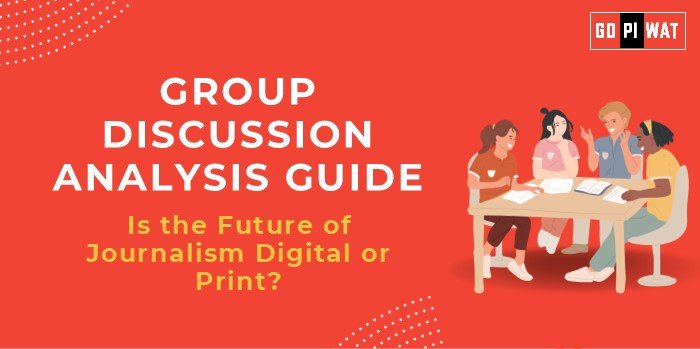📋 Group Discussion Analysis Guide: Is the Future of Journalism Digital or Print?
🌐 Introduction to the Topic
- 📜 Opening Context: The media landscape is transforming rapidly as digital platforms disrupt traditional print journalism. Understanding this shift is critical for aspiring B-school students, given its impact on marketing, communication strategies, and public perception.
- 📖 Topic Background: Journalism has evolved from newspapers and magazines to 24/7 digital platforms offering real-time updates. This transformation has raised questions about the survival of print media and the sustainability of digital journalism amidst rising misinformation and monetization challenges.
📊 Quick Facts and Key Statistics
- 🌐 Digital News Reach: Over 70% of global internet users consume news digitally, showcasing its growing dominance.
- 📰 Decline in Print Circulation: Newspaper circulation dropped by 25% globally in the past decade (Reuters Institute, 2023).
- 💰 Ad Revenue Distribution: Digital platforms command 75% of ad revenues, while print struggles with less than 20%.
- ⚠️ Misinformation Crisis: Over 60% of online users encountered fake news in 2023, challenging digital credibility.
- 📉 Sustainability Gap: Only 5% of digital platforms globally report consistent profits (Pew Research Center, 2023).
👥 Stakeholders and Their Roles
- 🏢 Media Houses: Transitioning to digital platforms or adopting hybrid models.
- 📱 Technology Giants: Controlling content visibility through algorithms (e.g., Google, Meta).
- 🏛️ Governments: Regulating misinformation and preserving press freedom.
- 🧑💻 Journalists: Adapting to multimedia storytelling and data-driven reporting.
- 👥 Audiences: Shaping trends through consumption preferences.
🏆 Achievements and Challenges
✨ Achievements
- 🌍 Global Reach: Digital journalism provides instant access to news worldwide, fostering awareness.
- 💸 Cost Efficiency: Online platforms reduce printing and distribution costs.
- 📣 Interactivity: Features like comment sections and live updates enhance user engagement.
- 📊 Data-Driven Insights: Analytics help media outlets tailor content to audience preferences.
⚠️ Challenges
- ❌ Misinformation: The rise of unverified content on social media damages credibility.
- 📉 Revenue Models: Declining ad revenues and paywall resistance threaten sustainability.
- 🌐 Access Inequality: Rural and underprivileged areas still lack robust digital infrastructure.
- 🌀 Digital Overload: Information fatigue leads to diminished engagement.
Global Comparisons:
• Scandinavia: High subscription rates for digital platforms.
• Developing Nations: Limited internet access hinders digital adoption.
Case Study:
• The New York Times: Successfully transitioned to a digital-first model, generating over $500 million from digital subscriptions in 2023.
📢 Structured Arguments for Discussion
- 💬 Supporting Stance: “The shift to digital journalism ensures instant news delivery, global reach, and multimedia storytelling unmatched by print.”
- 🗣️ Opposing Stance: “Print journalism remains unparalleled in credibility and depth, essential in combating digital misinformation.”
- ⚖️ Balanced Perspective: “While digital journalism is the future, its success relies on addressing misinformation, revenue sustainability, and access disparities.”
📈 Effective Discussion Approaches
- 💡 Opening Approaches:
- Start with a statistic: “70% of global news consumers prefer digital platforms—where does print fit in?”
- Use a case study: “The New York Times’ digital-first strategy highlights opportunities, but at what cost?”
- 💡 Counter-Argument Handling:
- Acknowledge print’s role in credibility.
- Present data on digital transformation successes.
- Propose solutions to digital journalism’s challenges.
📊 Strategic Analysis of Strengths and Weaknesses
Strengths
- 🌐 Instant reach, global accessibility.
- 🎥 Multimedia integration.
Weaknesses
- ❌ High misinformation rates.
- 📉 Dependence on ad revenues.
Opportunities
- 🤖 AI-driven personalized news delivery.
- 🌐 Expanding rural digital access.
Threats
- 📛 Erosion of trust due to fake news.
- 🌀 Saturation of online platforms.
🎓 Connecting with B-School Applications
- 💡 Real-World Applications:
- Digital journalism intersects with marketing (content strategies), public relations, and ethical leadership.
- 💡 Sample Interview Questions:
- “How can journalism balance digital innovation with credibility?”
- “What role does journalism play in shaping consumer perceptions?”
- 💡 Insights for B-School Students:
- Explore media strategies for corporate branding.
- Analyze ethical dilemmas in digital content creation.
- Understand audience segmentation in digital markets.


